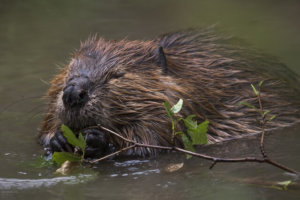Keystone species
 By Ethan Tapper
By Ethan Tapper
A keystone species is a species, usually of wildlife, that has a disproportionate effect on its environment. In our region, the classic example of this is the beaver.
Beavers dam and flood fields and forests, essentially creating, or driving, their own natural disturbance events. Besides making great habitat for themselves, they support a whole ecosystem, home to many reptiles, amphibians, birds, mammals, plants and more. Even once abandoned and drained, beaver meadows provide unique habitats across our landscape. While it sometimes causes problems for us, the work of beavers has human benefits, improving water quality and lessening the effects of flood events on our infrastructure.
We have long known that forests influence wildlife, but beavers are an example of how wildlife influence forest development. We increasingly understand these connections, from the blue jays that transport and plant acorns, to the rodents that help expand forests’ critical mycorrhizal fungal networks, to the woodpeckers that control populations of wood-boring insects.
Beavers are also an example of how, while it may seem counterintuitive, some disturbances—the events that kill trees—are actually good for forests. They, and the natural regeneration that follows them, help make forests diverse, resilient, and provide great wildlife habitat. While the gnawing and flooding of beavers kills trees, it creates broader ecosystem benefits that ultimately make forests healthier.
In this vein, a less well-known historic example of a keystone species is the passenger pigeon, which once populated our region in mega-flocks of billions of birds. John James Audubon described a forest following a visit from such a flock as looking like a “tornado” had hit it, breaking off trees “two feet in diameter.” While a mega-flock visit to your neighborhood would have been startling, to say the least, the “early successional” or “young forest” habitat that regenerated in their aftermath would have provided unique habitat for a huge number of wildlife species, including several bird species whose populations are now declining in Vermont.
As with the beaver, the passenger pigeon created habitat for many other species and thus may be called a keystone species. Its extinction in the early 1900s represented a loss for our wildlife and ultimately for our forests as well.
The recent resurgence of gray wolves, grizzly bears and mountain lions on our western landscapes illustrates how predators can also act as keystone species. They do so by influencing herbivory pressure, which in turn impacts reforestation and thus ecosystems and their natural processes.
In Vermont, predator-prey dynamics have changed drastically over the last 300 years.
Prior to the 1800s the dominant herbivores on Vermont’s landscape were caribou, moose and the eastern elk, with small populations of white-tailed deer, and the apex predators were wolves and catamounts. Elk and caribou disappeared from Vermont by the late 1700s (eastern elk is now extinct), deer hunting was closed in 1865 due to low populations, and wolves and catamounts were driven out by the late 1800s (the catamount, or eastern cougar, was declared extinct in 2018).
Reintroduced to Vermont in 1878, deer have become over-populated in much of New England, with dramatic negative impacts to forest health, diversity and wildlife habitat. In addition to the loss of predators, deer overpopulations in Vermont can be attributed largely to a diminishing influence of deer’s current apex predator—humans—due to crashing hunter numbers and increases in inaccessible, posted land.
Beavers are a success story. While extirpated from Vermont in the 1800s, they were reintroduced in 1932, and their populations are now healthy and growing. But catamounts, elk and passenger pigeons are never returning to Vermont’s landscape. What does the loss of a species like this mean for us and for our forests?
At the same time that we look back at what we’ve lost, we continue to create new challenges for our forests. Our climate is changing, invasive-exotic species threaten our biodiversity, and over 2,000 acres of Vermont’s forestland is lost each year (and is being fragmented much more quickly).
Humans have power like no other species to degrade our environment but also to shape it in a positive way. By acting to manage our forests responsibly, actively addressing the threats of invasive species, deer overabundance, climate change and more, we have the opportunity to become a keystone species; using this power to help our forests become healthier, more diverse, more resilient, and to provide rich, abundant habitat for all of our wildlife.
Ethan Tapper is the Chittenden County forester. He can be reached via email or by phone at (802) 585-9099.
